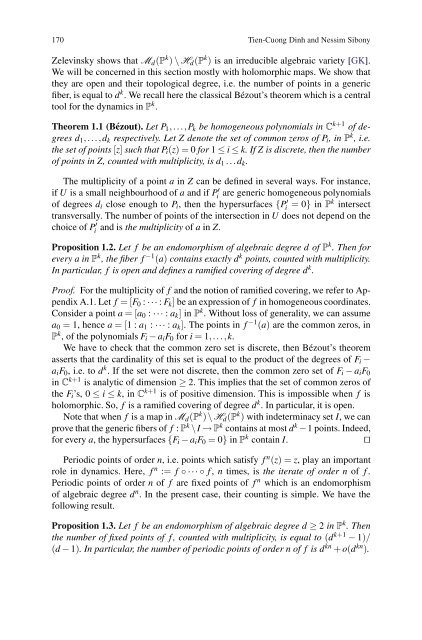Discrete Holomorphic Local Dynamical Systems
Discrete Holomorphic Local Dynamical Systems
Discrete Holomorphic Local Dynamical Systems
Create successful ePaper yourself
Turn your PDF publications into a flip-book with our unique Google optimized e-Paper software.
170 Tien-Cuong Dinh and Nessim Sibony<br />
Zelevinsky shows that Md(P k ) \ Hd(P k ) is an irreducible algebraic variety [GK].<br />
We will be concerned in this section mostly with holomorphic maps. We show that<br />
they are open and their topological degree, i.e. the number of points in a generic<br />
fiber, is equal to d k . We recall here the classical Bézout’s theorem which is a central<br />
tool for the dynamics in P k .<br />
Theorem 1.1 (Bézout). Let P1,...,Pk be homogeneous polynomials in C k+1 of degrees<br />
d1,...,dk respectively. Let Z denote the set of common zeros of Pi, inP k ,i.e.<br />
the set of points [z] such that Pi(z)=0 for 1 ≤ i ≤ k. If Z is discrete, then the number<br />
of points in Z, counted with multiplicity, is d1 ...dk.<br />
The multiplicity of a point a in Z can be defined in several ways. For instance,<br />
if U is a small neighbourhood of a and if P ′<br />
i are generic homogeneous polynomials<br />
of degrees di close enough to Pi, then the hypersurfaces {P ′<br />
i = 0} in Pk intersect<br />
transversally. The number of points of the intersection in U does not depend on the<br />
choice of P ′<br />
i and is the multiplicity of a in Z.<br />
Proposition 1.2. Let f be an endomorphism of algebraic degree d of P k . Then for<br />
every a in P k , the fiber f −1 (a) contains exactly d k points, counted with multiplicity.<br />
In particular, f is open and defines a ramified covering of degree d k .<br />
Proof. For the multiplicity of f and the notion of ramified covering, we refer to Appendix<br />
A.1. Let f =[F0 : ···: Fk] be an expression of f in homogeneous coordinates.<br />
Consider a point a =[a0 : ··· : ak] in P k . Without loss of generality, we can assume<br />
a0 = 1, hence a =[1:a1 : ··· : ak]. The points in f −1 (a) are the common zeros, in<br />
P k , of the polynomials Fi − aiF0 for i = 1,...,k.<br />
We have to check that the common zero set is discrete, then Bézout’s theorem<br />
asserts that the cardinality of this set is equal to the product of the degrees of Fi −<br />
aiF0, i.e.tod k . If the set were not discrete, then the common zero set of Fi − aiF0<br />
in C k+1 is analytic of dimension ≥ 2. This implies that the set of common zeros of<br />
the Fi’s, 0 ≤ i ≤ k, inC k+1 is of positive dimension. This is impossible when f is<br />
holomorphic. So, f is a ramified covering of degree d k . In particular, it is open.<br />
Note that when f is a map in Md(P k )\Hd(P k ) with indeterminacy set I, we can<br />
prove that the generic fibers of f : P k \I → P k contains at most d k −1 points. Indeed,<br />
for every a, the hypersurfaces {Fi − aiF0 = 0} in P k contain I. ⊓⊔<br />
Periodic points of order n, i.e. points which satisfy f n (z)=z, play an important<br />
role in dynamics. Here, f n := f ◦···◦ f , n times, is the iterate of order n of f .<br />
Periodic points of order n of f are fixed points of f n which is an endomorphism<br />
of algebraic degree d n . In the present case, their counting is simple. We have the<br />
following result.<br />
Proposition 1.3. Let f be an endomorphism of algebraic degree d ≥ 2 in P k .Then<br />
the number of fixed points of f , counted with multiplicity, is equal to (d k+1 − 1)/<br />
(d − 1). In particular, the number of periodic points of order n of f is d kn + o(d kn ).



